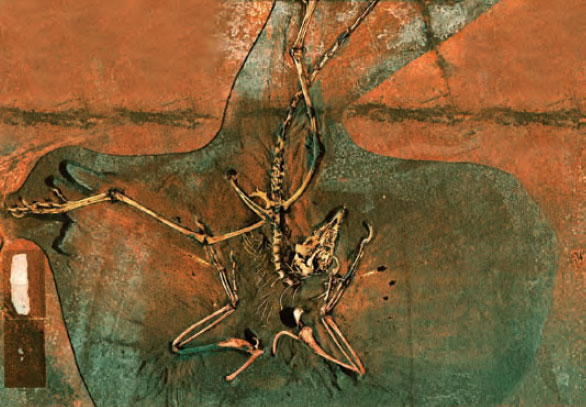Hey, waiter! There's a feather in my fossil!
 |
| Image: K.G. Huntley from data collected at SSRL/SLAC |
One hundred and fifty million years ago, a creature part dinosaur and part bird sank into the murky depths of a lagoon, never to fly again. Its fossilized remains, unearthed from a German limestone quarry, are the most complete and best preserved of the 10 known fossils of Archaeopteryx, the famous evolutionary link between dinosaurs and birds.
In December 2008, this urvogel—German for “primordial bird”—traveled from its home at the Wyoming Dinosaur Center to SLAC National Accelerator Laboratory for the first-ever chemical analysis of a dinobird specimen, performed by an unlikely mix of physicists, paleontologists, and geochemists from around the world.
Their tool was a powerful X-ray beam generated by electrons racing around a particle storage ring at SLAC's Stanford Synchrotron Radiation Lightsource. Sweeping the hair-thin beam over the 40-by-40-centimeter fossil, the team found remnants of the bird's original chemistry, including phosphorus, sulfur, copper, and zinc.
“For 50 years, everyone has assumed that these beautiful feather impressions were nothing but impressions,” says University of Manchester geochemist Roy Wogelius. “But they're not. The feather shafts are still there. There's actually original chemistry left.”
What's more, trace metals in the fossil, including copper and zinc, are “undoubtedly from the bones,” says SLAC physicist Uwe Bergmann. This suggests that Archaeopteryx, like modern birds, needed these elements in its diet to stay healthy.
“Quite simply, there's much more inside of fossils than we ever imagined,” says University of Manchester paleontologist Phil Manning. “There's gobsmackingly exciting stuff on the horizon; I think we have hit on some very exciting modern science. But this science can't happen without people who work out of their box. This work is the result of completely unrelated sciences all coming together and making a perfect storm.”
It wasn't the first time chemical traces of the original animal have been found in a fossil. But until recently the techniques were too slow and too lacking in detail for practical use. Now they have improved to the point that researchers could detect not just chemicals from the dinobird, but also the chemical processes involved in its fossilization, materials that had been used in its restoration, and even fingerprints on its stony surface.
Kelen Tuttle
Click here to download the pdf version of this article.






